Optimization and Scheduling Method for Power Systems Considering Wind Power Forward/Reverse Peaking Scenarios
Abstract
1. Introduction
2. Wind Power Characteristics Study
2.1. Analysis of Wind Power Forward/Reverse Peaking Characteristics
2.2. Analysis of Wind Power Consumption Mechanism under Forward/Reverse Peaking Scenarios
3. Multi-Timescale Scheduling Model Considering Wind Power Forward/Reverse Peaking Scenarios
3.1. Multi-Timescale Models
3.2. Day-Ahead Scheduling Model
3.2.1. Objective Function
3.2.2. Binding Conditions
3.2.3. Optimization Results
3.3. Intra-Day Scheduling Model
3.3.1. Objective Function
3.3.2. Binding Conditions
3.3.3. Optimization Results
4. Example Analysis
4.1. Example Overview
4.2. Analysis of Scheduling Results
4.3. Comparison Analysis of Different Scheduling Modes
- (1)
- No energy storage plants are involved, while no multi-timescale dispatch is considered and only the thermal power units are involved in peaking;
- (2)
- Add DR resources on the basis of scheme (1) and only perform the day-ahead scheduling;
- (3)
- Based on the scheduling method proposed in this paper.
5. Conclusions
Author Contributions
Funding
Data Availability Statement
Conflicts of Interest
References
- Qays, M.O.; Ahmad, I.; Habibi, D.; Aziz, A.; Mahmoud, T. System Strength Shortfall Challenges for Renewable Energy-Based Power Systems: A Review. Renew. Sustain. Energy Rev. 2023, 183, 113447. [Google Scholar] [CrossRef]
- Liu, L.; Xu, J. Multi-Objective Generation Scheduling towards Grid-Connected Hydro–Solar–Wind Power System Based the Coordination of Economy, Management, Society, Environment: A Case Study from China. Int. J. Electr. Power Energy Syst. 2022, 142, 108210. [Google Scholar] [CrossRef]
- Yang, C.; Wu, Z.; Li, X.; Fars, A. Risk-Constrained Stochastic Scheduling for Energy Hub: Integrating Renewables, Demand Response, and Electric Vehicles. Energy 2024, 288, 129680. [Google Scholar] [CrossRef]
- Li, S.; Zhao, X.; Liang, W.; Hossain, M.T.; Zhang, Z. A Fast and Accurate Calculation Method of Line Breaking Power Flow Based on Taylor Expansion. Front. Energy Res. 2022, 10, 943946. [Google Scholar] [CrossRef]
- Yang, Y.; Si, Z.; Jia, L.; Wang, P.; Huang, L.; Zhang, Y.; Ji, C. Whether Rural Rooftop Photovoltaics Can Effectively Fight the Power Consumption Conflicts at the Regional Scale—A Case Study of Jiangsu Province. Energy Build. 2024, 306, 113921. [Google Scholar] [CrossRef]
- National Energy Administration releases the statistical data of national electric power industry from January to March. Electr. Power Surv. Des. 2023, 4, 98.
- Porate, K.B.; Thakre, K.L.; Bodhe, G.L. Impact of Wind Power on Generation Economy and Emission from Coal Based Thermal Power Plant. Int. J. Electr. Power Energy Syst. 2013, 44, 889–896. [Google Scholar] [CrossRef]
- Li, L.; Li, Y.; Zhou, B.; Wu, Q.; Shen, X.; Liu, H.; Gong, Z. An Adaptive Time-Resolution Method for Ultra-Short-Term Wind Power Prediction. Int. J. Electr. Power Energy Syst. 2020, 118, 105814. [Google Scholar] [CrossRef]
- Bird, L.; Lew, D.; Milligan, M.; Carlini, E.M.; Estanqueiro, A.; Flynn, D.; Gomez-Lazaro, E.; Holttinen, H.; Menemenlis, N.; Orths, A.; et al. Wind and Solar Energy Curtailment: A Review of International Experience. Renew. Sustain. Energy Rev. 2016, 65, 577–586. [Google Scholar] [CrossRef]
- Simla, T.; Stanek, W. Influence of the Wind Energy Sector on Thermal Power Plants in the Polish Energy System. Renew. Energy 2020, 161, 928–938. [Google Scholar] [CrossRef]
- Emblemsvåg, J. Wind Energy Is Not Sustainable When Balanced by Fossil Energy. Appl. Energy 2022, 305, 117748. [Google Scholar] [CrossRef]
- Zhao, C.; Wang, J.; Watson, J.-P.; Guan, Y. Multi-Stage Robust Unit Commitment Considering Wind and Demand Response Uncertainties. IEEE Trans. Power Syst. 2013, 28, 2708–2717. [Google Scholar] [CrossRef]
- Huang, W.; Zhang, N.; Kang, C.; Li, M.; Huo, M. From Demand Response to Integrated Demand Response: Review and Prospect of Research and Application. Prot. Control Mod. Power Syst. 2019, 4, 12. [Google Scholar] [CrossRef]
- Yang, Z.; Qin, Z. Demand Response Model by Locational Marginal Electricity–Carbon Price Considering Wind Power Uncertainty and Energy Storage Systems. Energy Rep. 2023, 9, 742–752. [Google Scholar] [CrossRef]
- De Jonghe, C.; Hobbs, B.F.; Belmans, R. Value of Price Responsive Load for Wind Integration in Unit Commitment. IEEE Trans. Power Syst. 2014, 29, 675–685. [Google Scholar] [CrossRef]
- Corinaldesi, C.; Schwabeneder, D.; Lettner, G.; Auer, H. A Rolling Horizon Approach for Real-Time Trading and Portfolio Optimization of End-User Flexibilities. Sustain. Energy Grids Netw. 2020, 24, 100392. [Google Scholar] [CrossRef]
- Behrangrad, M.; Sugihara, H.; Funaki, T. Analyzing the System Effects of Optimal Demand Response Utilization for Reserve Procurement and Peak Clipping. In Proceedings of the IEEE PES General Meeting, Minneapolis, MI, USA, 25–29 July 2010; pp. 1–7. [Google Scholar]
- Parvania, M.; Fotuhi-Firuzabad, M. Demand Response Scheduling by Stochastic SCUC. IEEE Trans. Smart Grid 2010, 1, 89–98. [Google Scholar] [CrossRef]
- Dietrich, K.; Latorre, J.M.; Olmos, L.; Ramos, A. Demand Response in an Isolated System with High Wind Integration. IEEE Trans. Power Syst. 2012, 27, 20–29. [Google Scholar] [CrossRef]
- Jin, S.; Botterud, A.; Ryan, S.M. Impact of Demand Response on Thermal Generation Investment with High Wind Penetration. IEEE Trans. Smart Grid 2013, 4, 2374–2383. [Google Scholar] [CrossRef]
- De Jonghe, C.; Hobbs, B.F.; Belmans, R. Optimal Generation Mix with Short-Term Demand Response and Wind Penetration. IEEE Trans. Power Syst. 2012, 27, 830–839. [Google Scholar] [CrossRef]
- Barth, R.; Brand, H.; Meibom, P.; Weber, C. A Stochastic Unit-Commitment Model for the Evaluation of the Impacts of Integration of Large Amounts of Intermittent Wind Power. In Proceedings of the 2006 International Conference on Probabilistic Methods Applied to Power Systems, Stockholm, Sweden, 11–15 June 2006; pp. 1–8. [Google Scholar]
- Tuohy, A.; Meibom, P.; Denny, E.; O’Malley, M. Unit Commitment for Systems with Significant Wind Penetration. IEEE Trans. Power Syst. 2009, 24, 592–601. [Google Scholar] [CrossRef]
- Siahkali, H.; Vakilian, M. Stochastic Unit Commitment of Wind Farms Integrated in Power System. Electr. Power Syst. Res. 2010, 80, 1006–1017. [Google Scholar] [CrossRef]
- Liu, G. Data Collection in MI-Assisted Wireless Powered Underground Sensor Networks: Directions, Recent Advances, and Challenges. IEEE Commun. Mag. 2021, 59, 132–138. [Google Scholar] [CrossRef]
- Li, S.; Wang, F.; Ouyang, L.; Chen, X.; Yang, Z.; Rozga, P.; Li, J.; Fofana, I. Differential Low-Temperature AC Breakdown between Synthetic Ester and Mineral Oils: Insights from Both Molecular Dynamics and Quantum Mechanics. IEEE Trans. Dielect. Electr. Insul. 2023, 1. [Google Scholar] [CrossRef]
- Papavasiliou, A.; Oren, S.S. A Stochastic Unit Commitment Model for Integrating Renewable Supply and Demand Response. In Proceedings of the 2012 IEEE Power and Energy Society General Meeting, San Diego, CA, USA, 22–26 July 2012; pp. 1–6. [Google Scholar]
- Wang, L.; Lin, J.; Dong, H.; Wang, Y.; Zeng, M. Demand Response Comprehensive Incentive Mechanism-Based Multi-Time Scale Optimization Scheduling for Park Integrated Energy System. Energy 2023, 270, 126893. [Google Scholar] [CrossRef]
- Chen, M.; Lu, H.; Chang, X.; Liao, H. An Optimization on an Integrated Energy System of Combined Heat and Power, Carbon Capture System and Power to Gas by Considering Flexible Load. Energy 2023, 273, 127203. [Google Scholar] [CrossRef]
- Wang, J.; Huo, S.; Yan, R.; Cui, Z. Leveraging Heat Accumulation of District Heating Network to Improve Performances of Integrated Energy System under Source-Load Uncertainties. Energy 2022, 252, 124002. [Google Scholar] [CrossRef]
- Gao, Q.; Yuan, R.; Ertugrul, N.; Ding, B.; Hayward, J.A.; Li, Y. Analysis of Energy Variability and Costs for Offshore Wind and Hybrid Power Unit with Equivalent Energy Storage System. Appl. Energy 2023, 342, 121192. [Google Scholar] [CrossRef]
- Li, Q.; Li, X.; Mi, J.; Jiang, B.; Chen, S.; Zuo, L. Tunable Wave Energy Converter Using Variable Inertia Flywheel. IEEE Trans. Sustain. Energy 2021, 12, 1265–1274. [Google Scholar] [CrossRef]
- Li, B.; DeCarolis, J.F. A Techno-Economic Assessment of Offshore Wind Coupled to Offshore Compressed Air Energy Storage. Appl. Energy 2015, 155, 315–322. [Google Scholar] [CrossRef]
- Roy, A.; Kedare, S.B.; Bandyopadhyay, S. Optimum Sizing of Wind-Battery Systems Incorporating Resource Uncertainty. Appl. Energy 2010, 87, 2712–2727. [Google Scholar] [CrossRef]
- Ceballos, S.; Rea, J.; Robles, E.; Lopez, I.; Pou, J.; O’Sullivan, D. Control Strategies for Combining Local Energy Storage with Wells Turbine Oscillating Water Column Devices. Renew. Energy 2015, 83, 1097–1109. [Google Scholar] [CrossRef]
- Zhao, H.; Wu, Q.; Hu, S.; Xu, H.; Rasmussen, C.N. Review of Energy Storage System for Wind Power Integration Support. Appl. Energy 2015, 137, 545–553. [Google Scholar] [CrossRef]
- Zafirakis, D.; Chalvatzis, K.J.; Baiocchi, G.; Daskalakis, G. Modeling of Financial Incentives for Investments in Energy Storage Systems That Promote the Large-Scale Integration of Wind Energy. Appl. Energy 2013, 105, 138–154. [Google Scholar] [CrossRef]
- Korpaas, M.; Holen, A.T.; Hildrum, R. Operation and Sizing of Energy Storage for Wind Power Plants in a Market System. Int. J. Electr. Power Energy Syst. 2003, 25, 599–606. [Google Scholar] [CrossRef]
- Liu, J.; Sun, X.; Bo, R.; Wang, S.; Ou, M. Economic Dispatch for Electricity Merchant with Energy Storage and Wind Plant: State of Charge Based Decision Making Considering Market Impact and Uncertainties. J. Energy Storage 2022, 53, 104816. [Google Scholar] [CrossRef]
- Li, Y.; Wang, J.; Zhang, Y.; Han, Y. Day-Ahead Scheduling Strategy for Integrated Heating and Power System with High Wind Power Penetration and Integrated Demand Response: A Hybrid Stochastic/Interval Approach. Energy 2022, 253, 124189. [Google Scholar] [CrossRef]
- Chen, C.; Wu, X.; Li, Y.; Zhu, X.; Li, Z.; Ma, J.; Qiu, W.; Liu, C.; Lin, Z.; Yang, L.; et al. Distributionally Robust Day-Ahead Scheduling of Park-Level Integrated Energy System Considering Generalized Energy Storages. Appl. Energy 2021, 302, 117493. [Google Scholar] [CrossRef]
- Chen, Z.; Zhang, Y.; Tang, W.; Lin, X.; Li, Q. Generic Modelling and Optimal Day-Ahead Dispatch of Micro-Energy System Considering the Price-Based Integrated Demand Response. Energy 2019, 176, 171–183. [Google Scholar] [CrossRef]
- Yang, H.; Liang, R.; Yuan, Y.; Chen, B.; Xiang, S.; Liu, J.; Zhao, H.; Ackom, E. Distributionally Robust Optimal Dispatch in the Power System with High Penetration of Wind Power Based on Net Load Fluctuation Data. Appl. Energy 2022, 313, 118813. [Google Scholar] [CrossRef]
- Hu, W.; Wang, T.; Chu, F. Novel Ramanujan Digital Twin for Motor Periodic Fault Monitoring and Detection. IEEE Trans. Ind. Inform. 2023, 19, 11564–11572. [Google Scholar] [CrossRef]
- Song, J.; Mingotti, A.; Zhang, J.; Peretto, L.; Wen, H. Accurate Damping Factor and Frequency Estimation for Damped Real-Valued Sinusoidal Signals. IEEE Trans. Instrum. Meas. 2022, 71, 1–4. [Google Scholar] [CrossRef]
- Kong, J.; Skjelbred, H.I.; Fosso, O.B. An Overview on Formulations and Optimization Methods for the Unit-Based Short-Term Hydro Scheduling Problem. Electr. Power Syst. Res. 2020, 178, 106027. [Google Scholar] [CrossRef]
- Hongbin, S.; Bi, Z. An Alternating Direction Method of Multipliers for Unit Commitment Optimization Based on Wind Power Accommodation. In Proceedings of the 2021 IEEE 2nd International Conference on Big Data, Artificial Intelligence and Internet of Things Engineering (ICBAIE), Nanchang, China, 26–28 March 2021; pp. 952–955. [Google Scholar]
- Xu, B.; Oudalov, A.; Ulbig, A.; Andersson, G.; Kirschen, D.S. Modeling of Lithium-Ion Battery Degradation for Cell Life Assessment. IEEE Trans. Smart Grid 2018, 9, 1131–1140. [Google Scholar] [CrossRef]


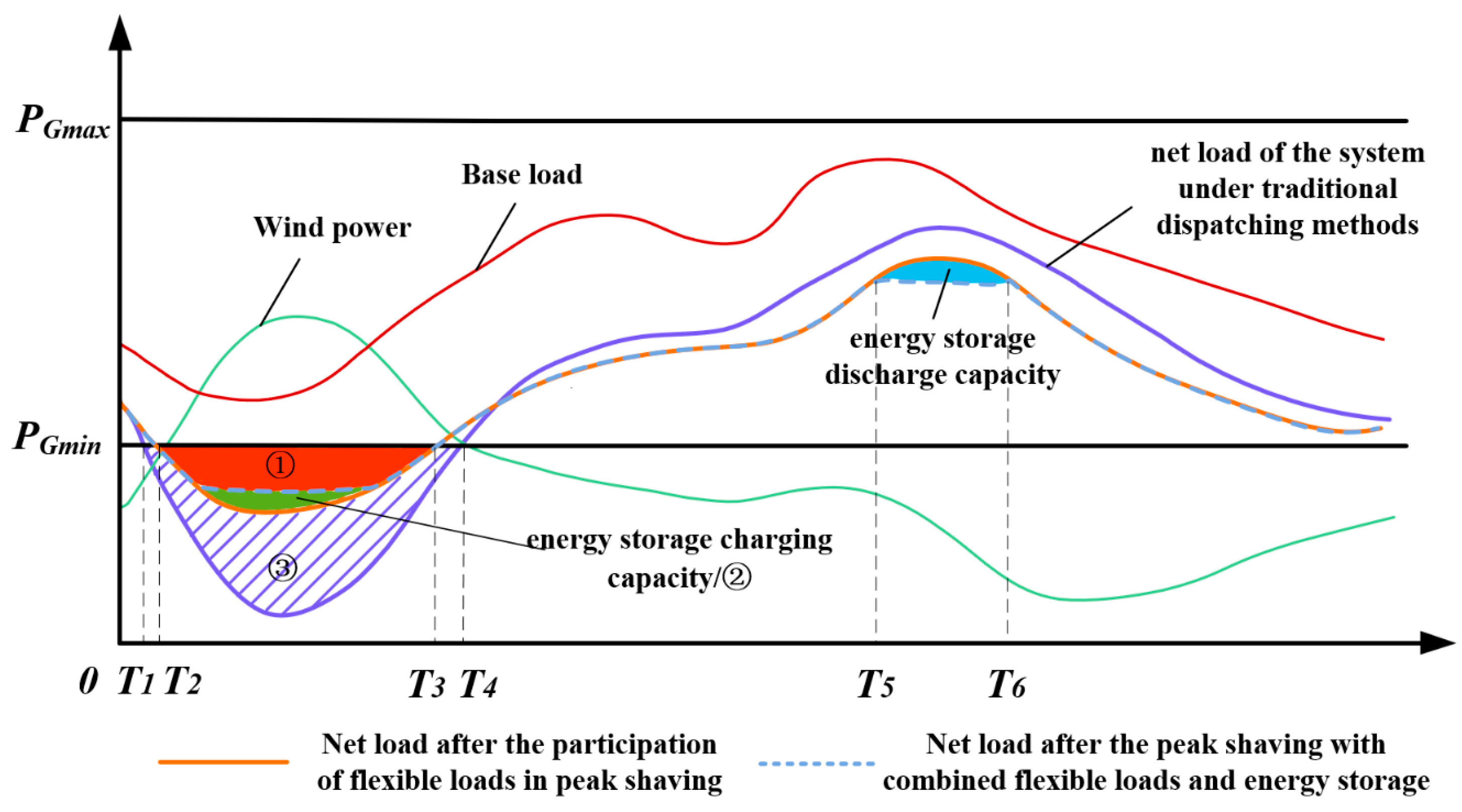
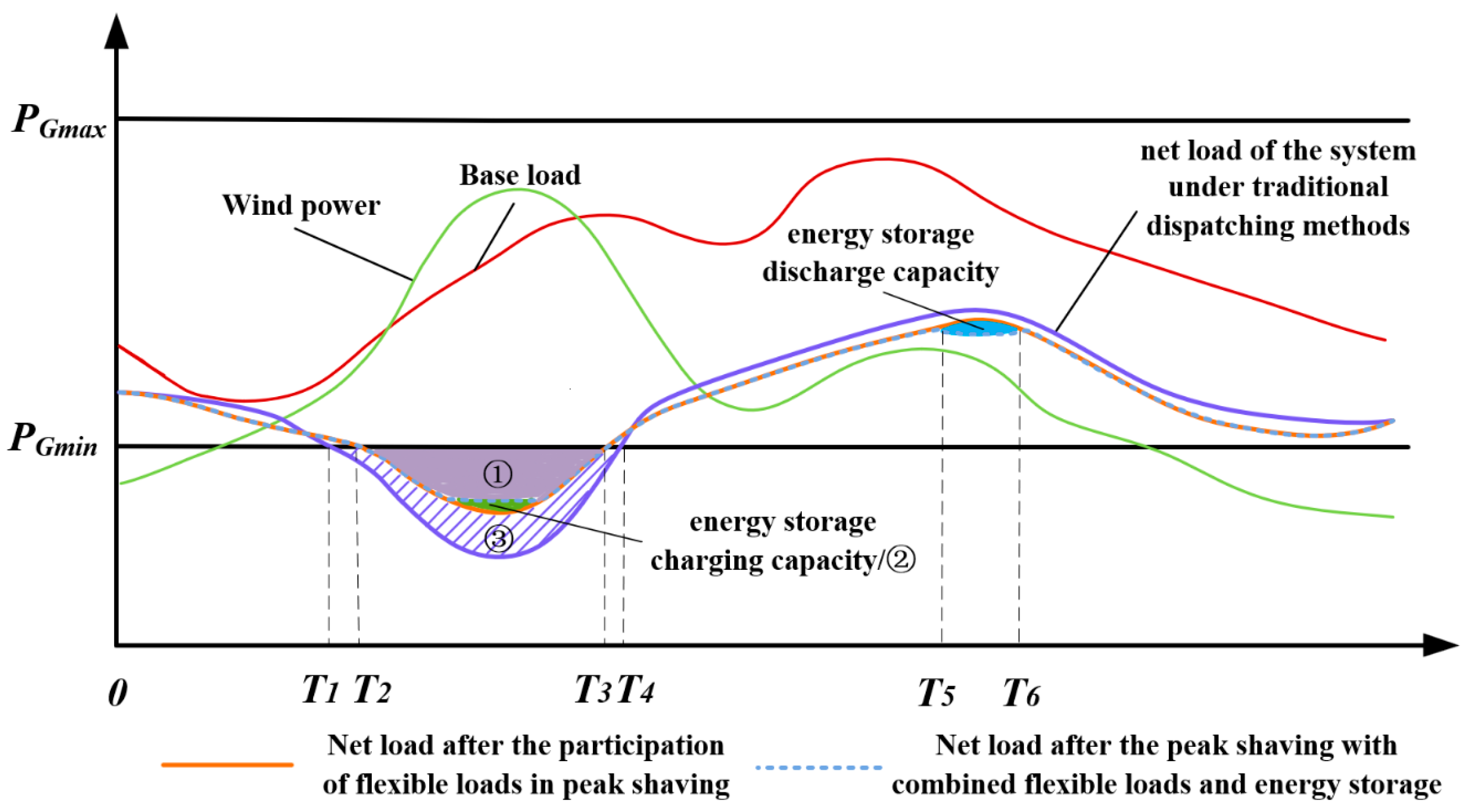

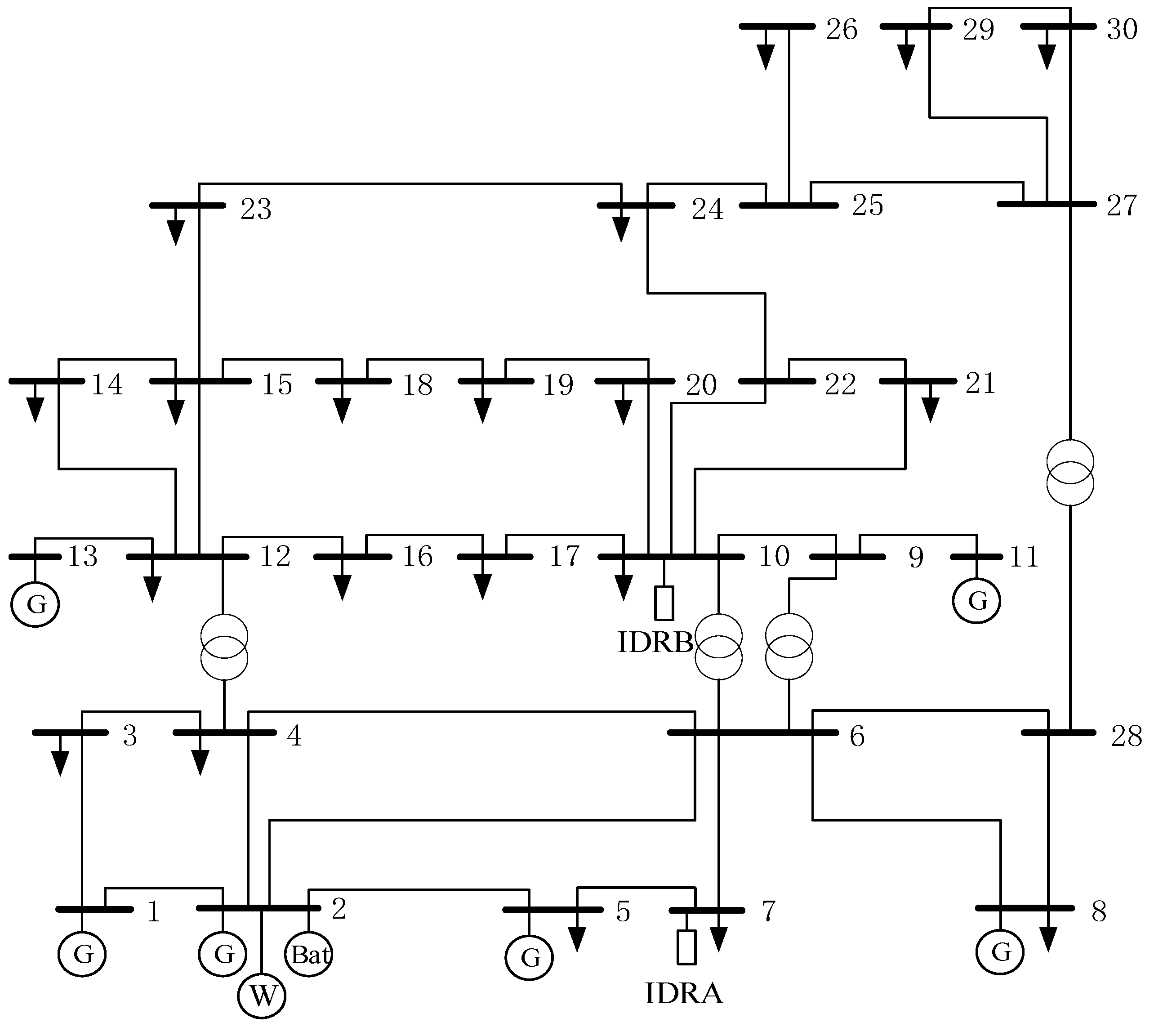
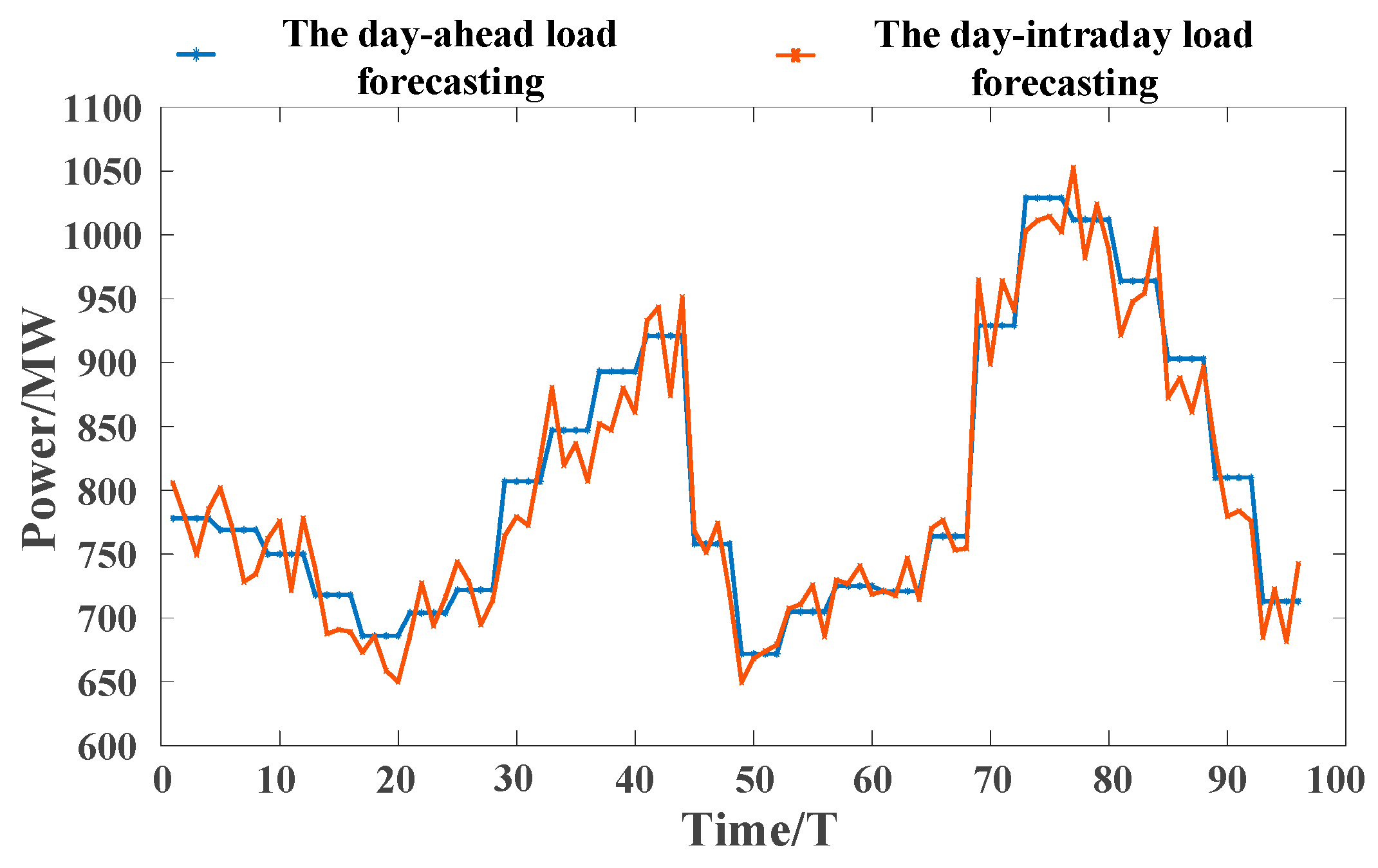
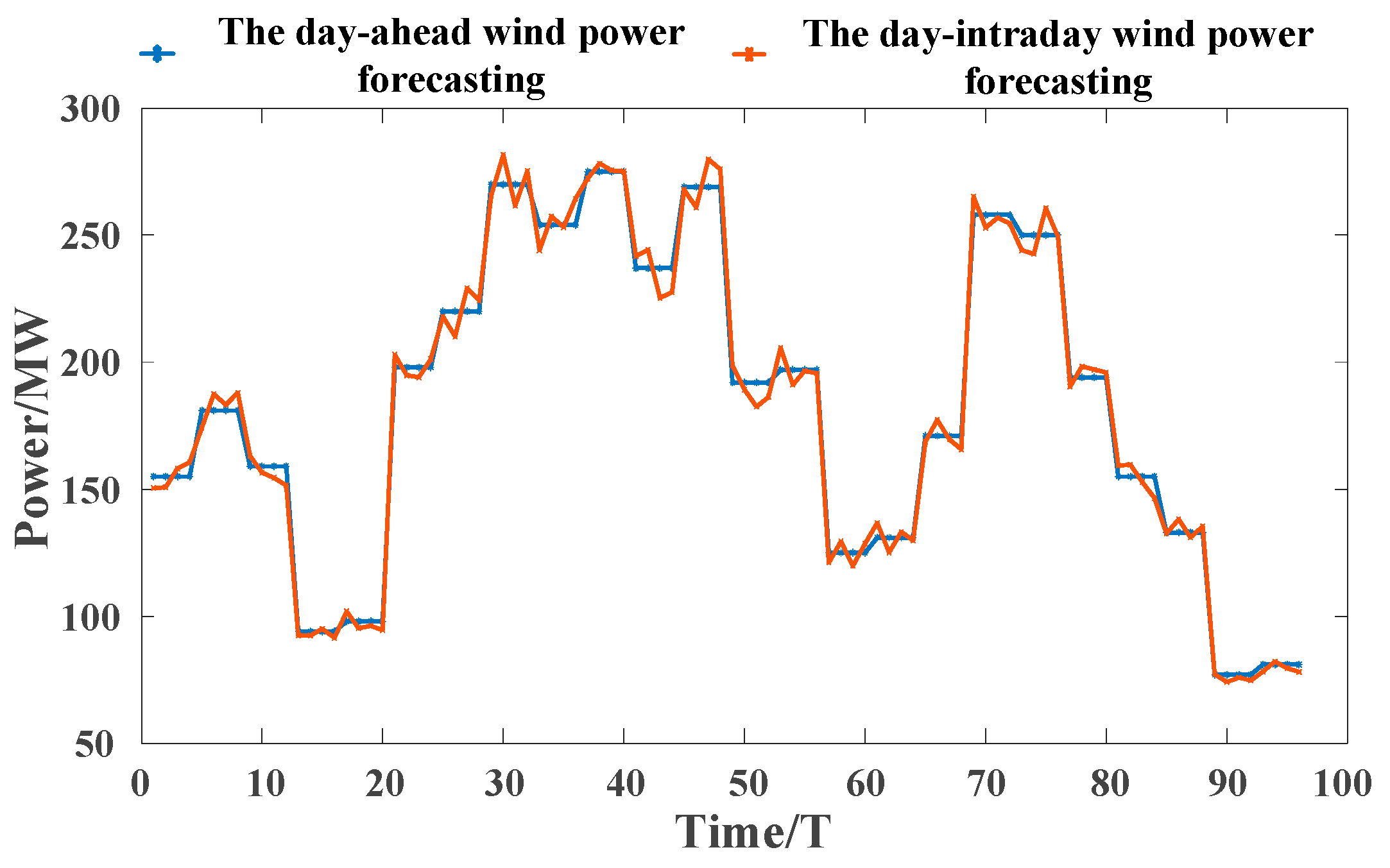
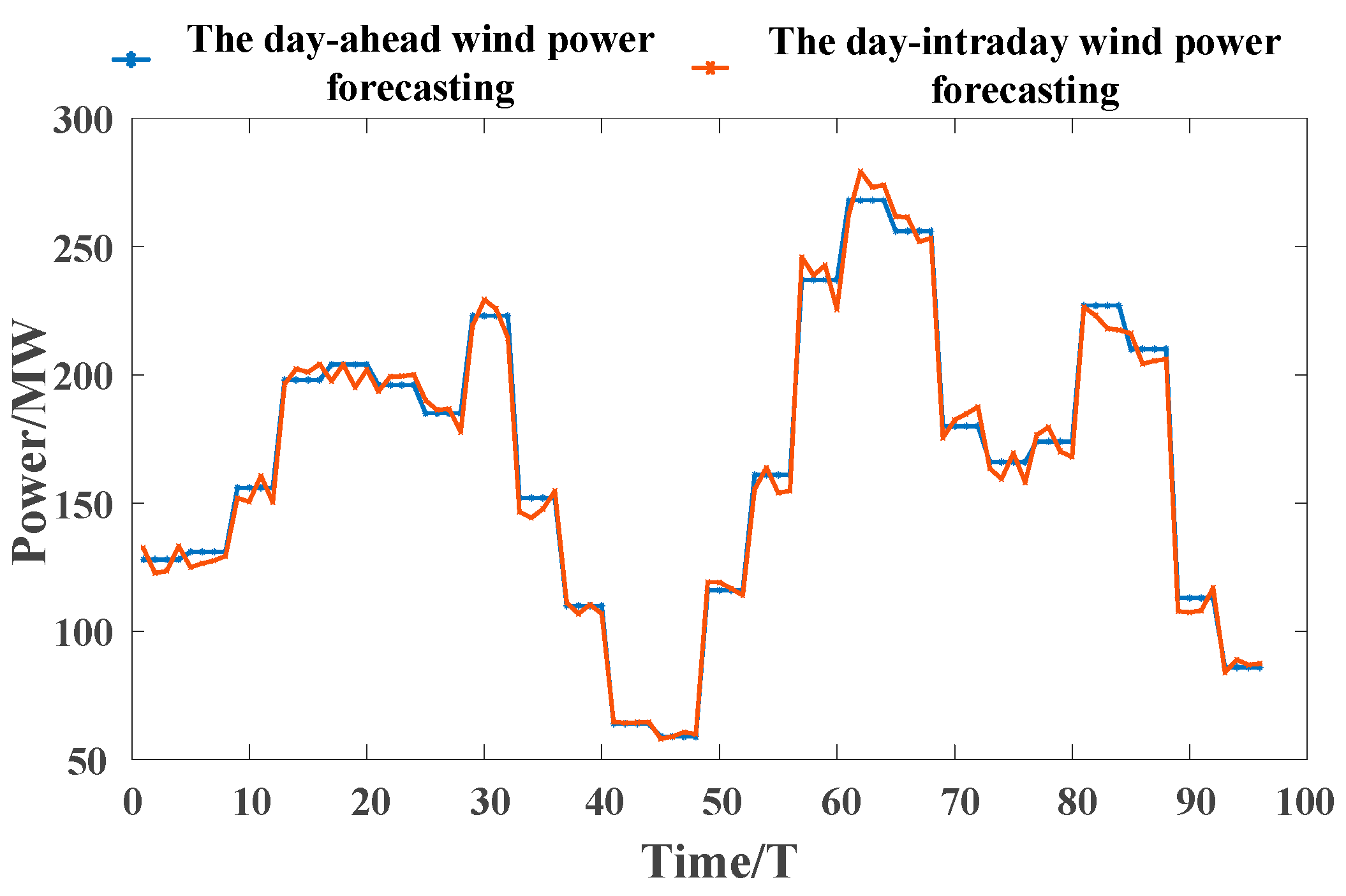
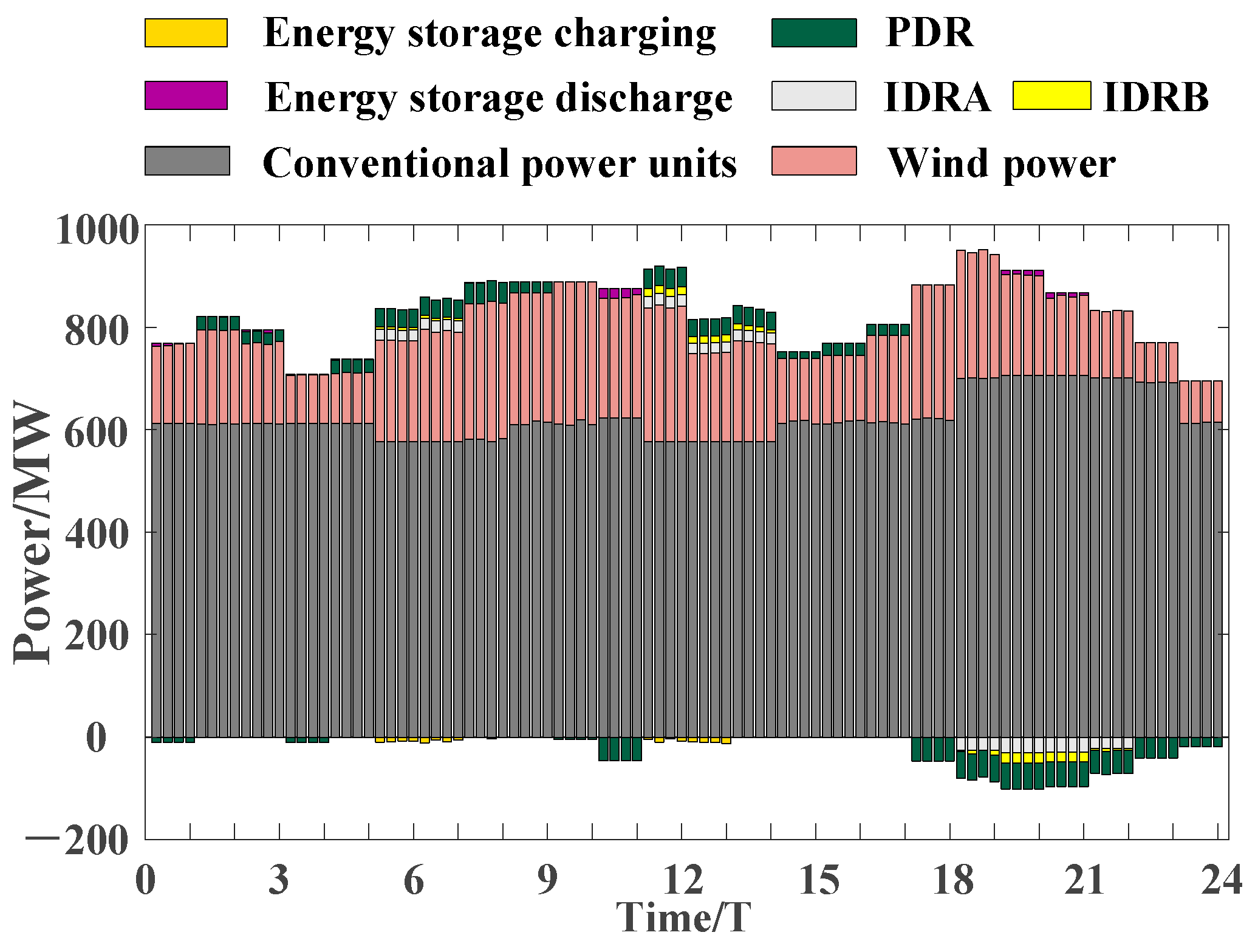
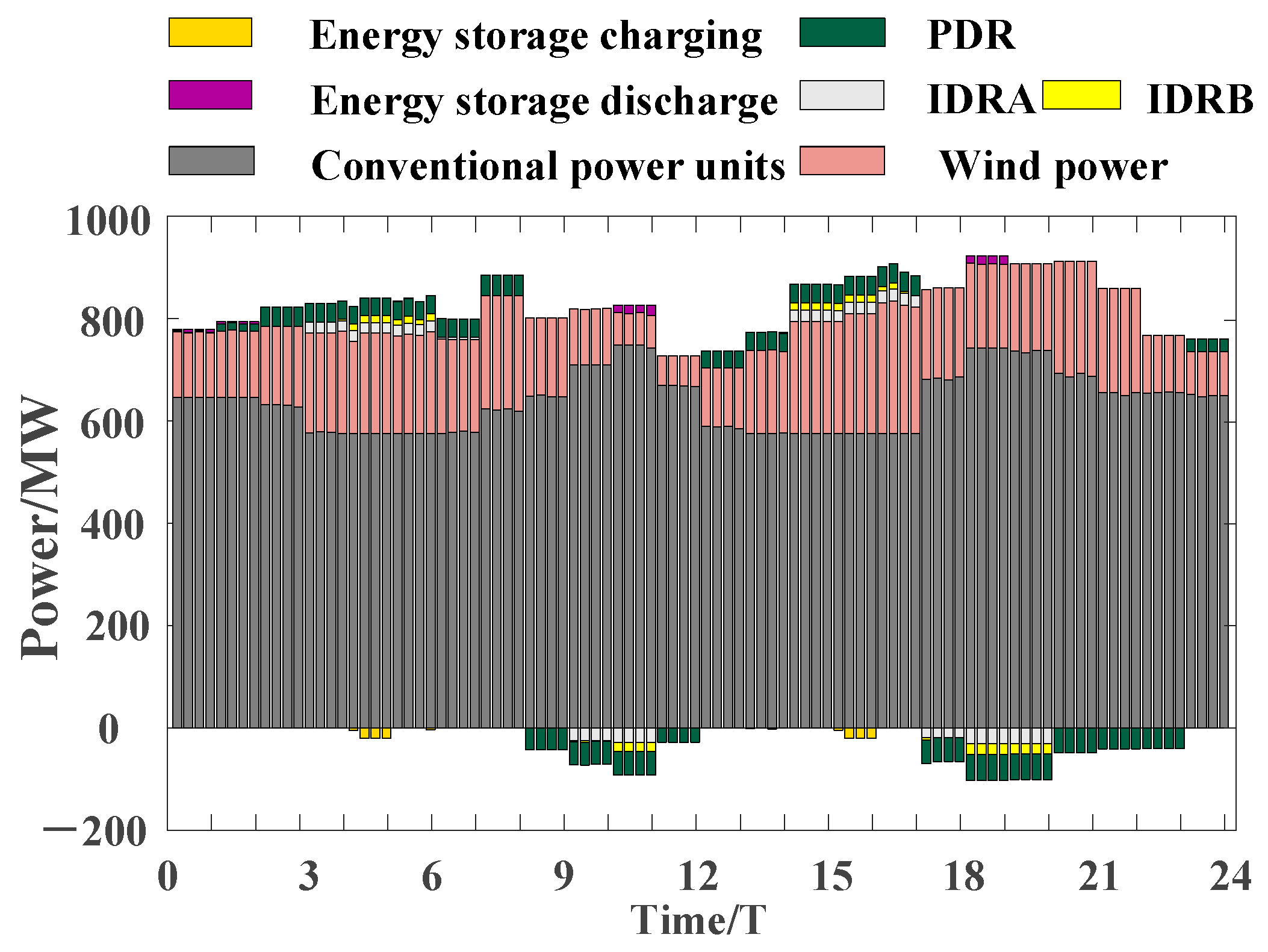
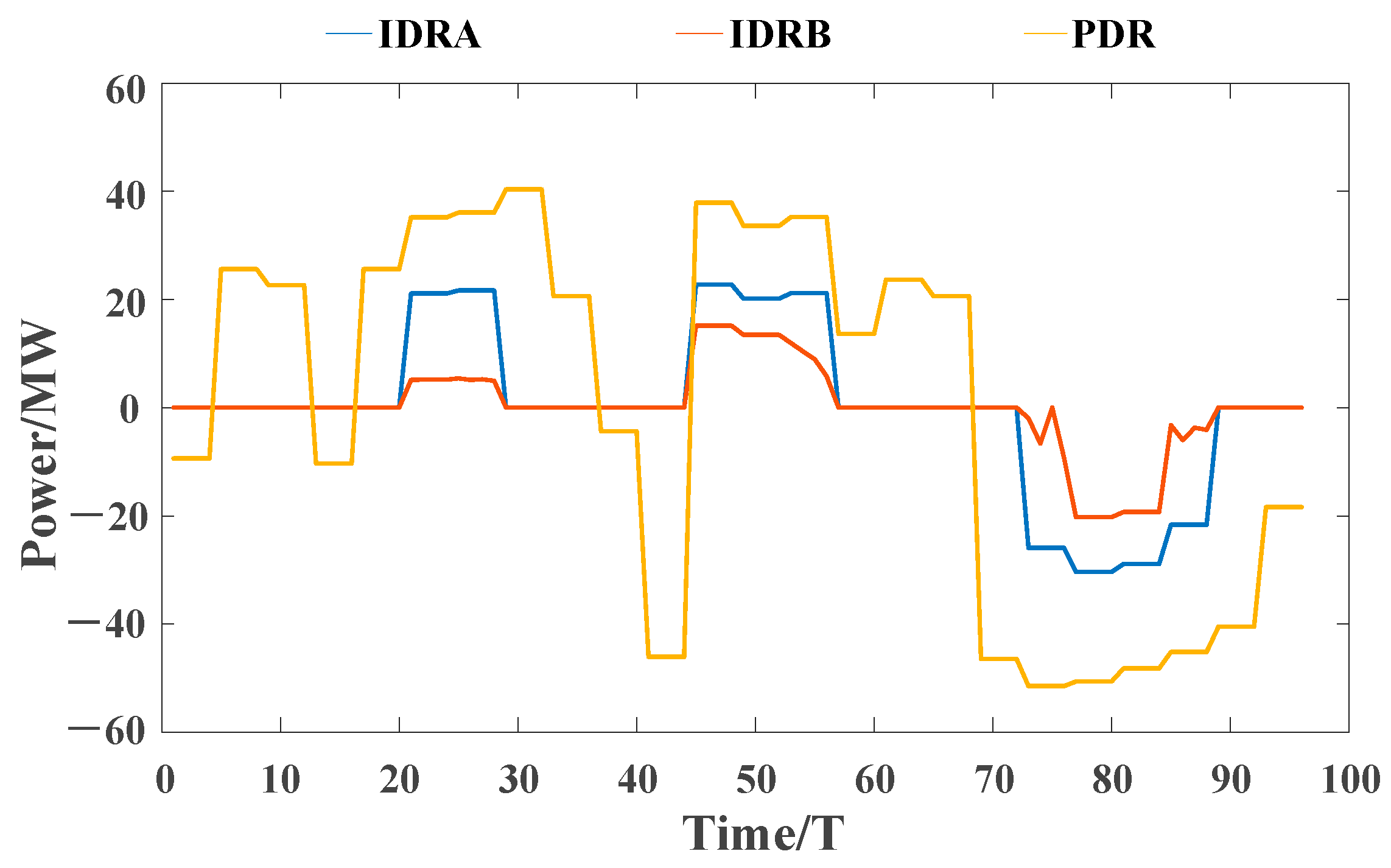
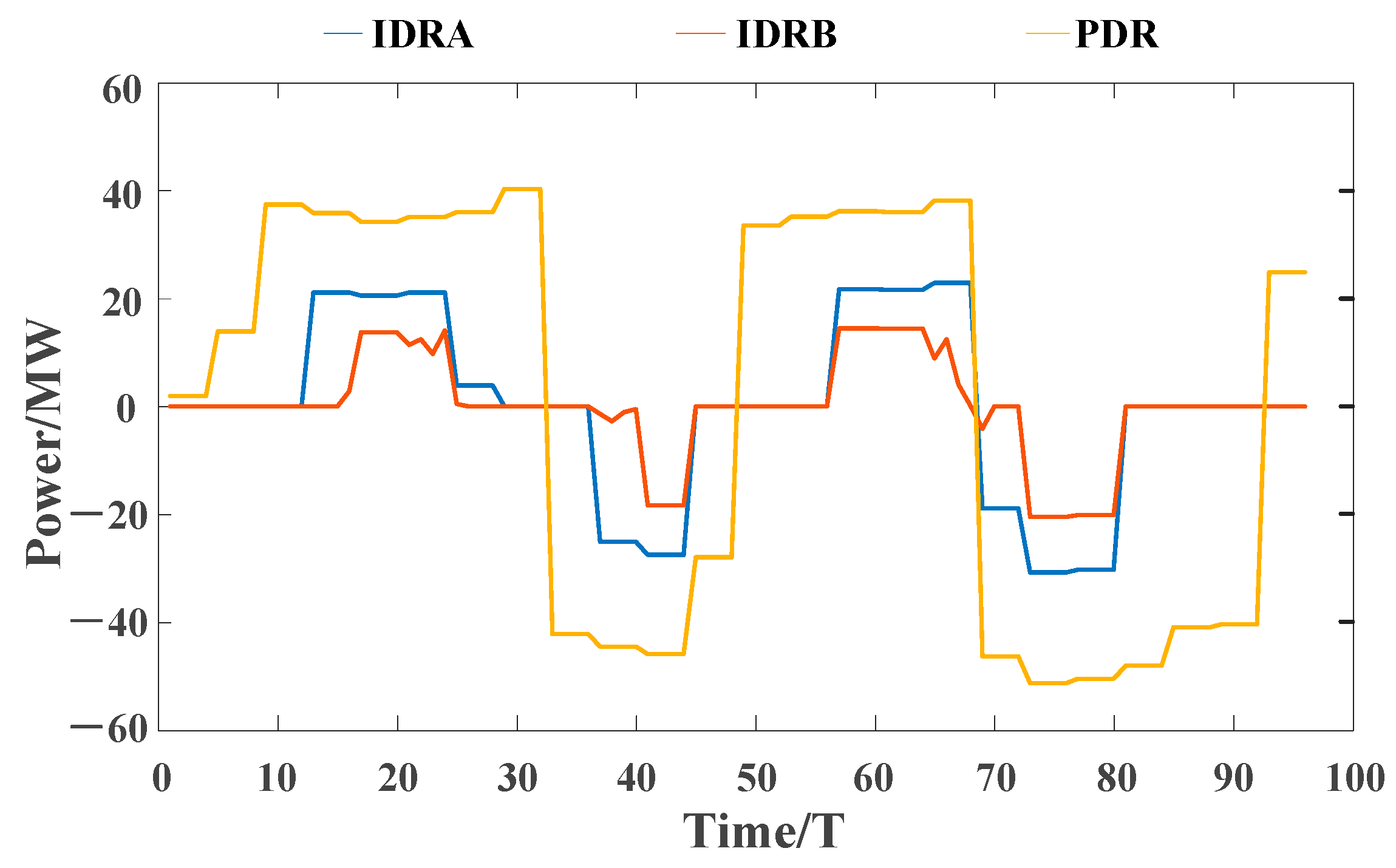
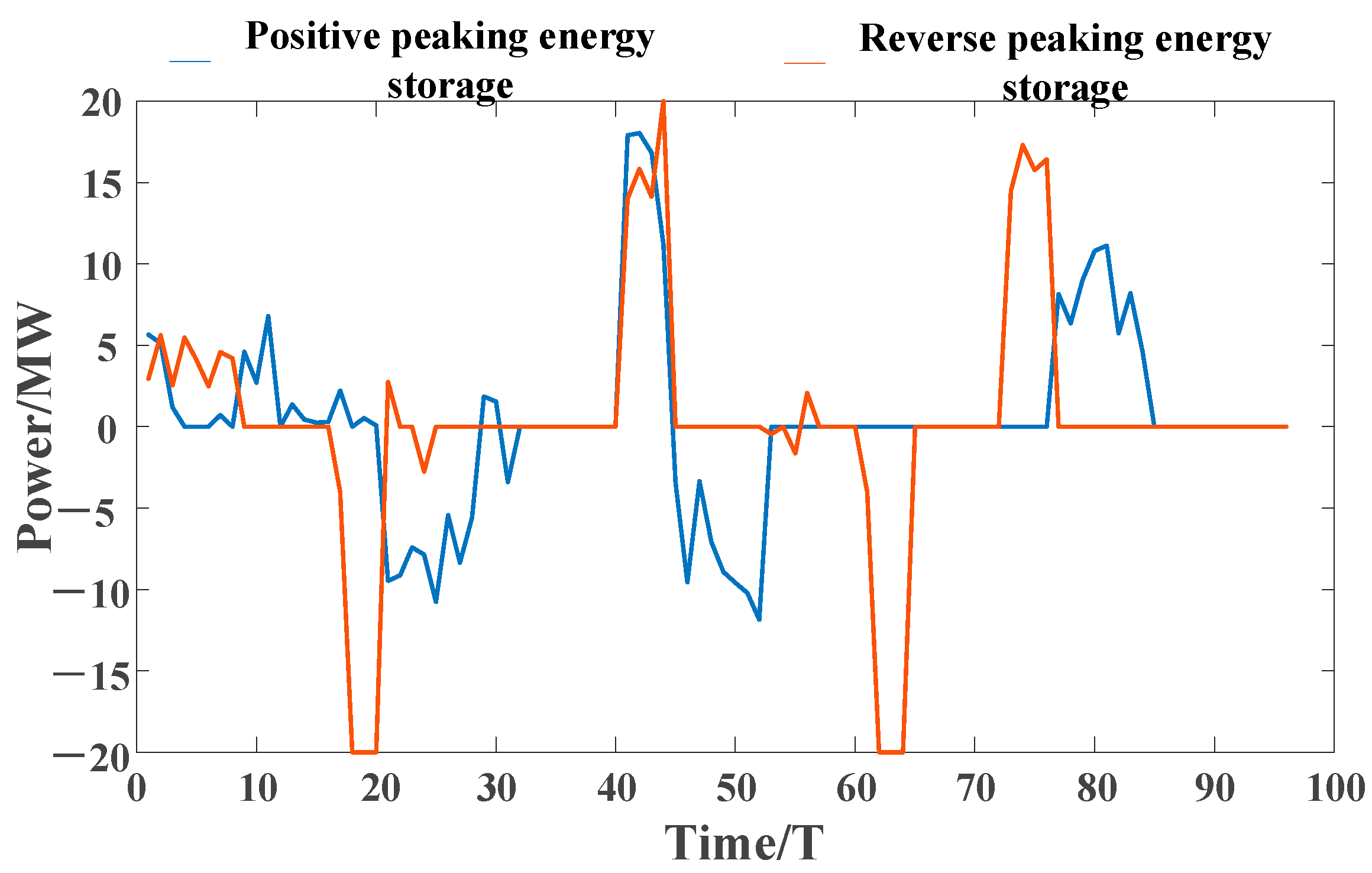
| Thermal Power Units | Power/MW | Price/(CNY/MW2·h) | |||
|---|---|---|---|---|---|
| Pmax | Pmin | a | b | c | |
| G1 | 405 | 259 | 0.00048 | 16.19 | 1000 |
| G2 | 165 | 94 | 0.00398 | 19.7 | 450 |
| G3 | 160 | 94 | 0.00411 | 21.5 | 316.5 |
| G4 | 182 | 68 | 0.00334 | 32.5 | 329.2 |
| G5 | 65 | 35 | 0.0025 | 30 | 276.4 |
| G6 | 60 | 27 | 0.0025 | 30 | 232.2 |
| Type | Response Speed | Scheduling Timescale |
|---|---|---|
| Class A IDR | >1 h | 1 h |
| Class B IDR | 15 min~4 h | 15 min |
| Scheduling Plan | Thermal Power Costs/CNY | Cost of IDR/CNY | Wind Curtailment Costs/CNY | Total Cost/CNY |
|---|---|---|---|---|
| Option 1 | 487,718 | 0 | 159,430 | 647,216 |
| Option 2 | 427,240 | 12,514 | 50,797 | 490,632 |
| Option 3 | 410,393 | 19,411 | 16,345 | 446,281 |
Disclaimer/Publisher’s Note: The statements, opinions and data contained in all publications are solely those of the individual author(s) and contributor(s) and not of MDPI and/or the editor(s). MDPI and/or the editor(s) disclaim responsibility for any injury to people or property resulting from any ideas, methods, instructions or products referred to in the content. |
© 2024 by the authors. Licensee MDPI, Basel, Switzerland. This article is an open access article distributed under the terms and conditions of the Creative Commons Attribution (CC BY) license (https://creativecommons.org/licenses/by/4.0/).
Share and Cite
Yu, H.; Wang, Y.; Liu, C.; Wang, S.; Hao, C.; Xiong, J. Optimization and Scheduling Method for Power Systems Considering Wind Power Forward/Reverse Peaking Scenarios. Energies 2024, 17, 1257. https://doi.org/10.3390/en17051257
Yu H, Wang Y, Liu C, Wang S, Hao C, Xiong J. Optimization and Scheduling Method for Power Systems Considering Wind Power Forward/Reverse Peaking Scenarios. Energies. 2024; 17(5):1257. https://doi.org/10.3390/en17051257
Chicago/Turabian StyleYu, Hao, Yibo Wang, Chuang Liu, Shunjiang Wang, Chunyang Hao, and Jian Xiong. 2024. "Optimization and Scheduling Method for Power Systems Considering Wind Power Forward/Reverse Peaking Scenarios" Energies 17, no. 5: 1257. https://doi.org/10.3390/en17051257
APA StyleYu, H., Wang, Y., Liu, C., Wang, S., Hao, C., & Xiong, J. (2024). Optimization and Scheduling Method for Power Systems Considering Wind Power Forward/Reverse Peaking Scenarios. Energies, 17(5), 1257. https://doi.org/10.3390/en17051257





